WeatherFlow Windmeter: Essential Guide for Kiteboarding


Intro
Kiteboarding is an exhilarating sport that combines the thrill of surfing with the finesse of flying, drawing enthusiasts to beaches around the world. Navigating the waters is a dance between skill and nature, but the foundation for an outstanding kiteboarding experience rests heavily on understanding the wind. Enter the WeatherFlow Windmeter—a device that provides kiteboarders with real-time, precise wind data. Knowing when the winds are favorable can mean the difference between a joy-filled afternoon and a frustrating day on the water.
In this guide, we’ll explore the WeatherFlow Windmeter in detail. We’ll unpack its features, shed light on how to set it up and use it effectively, and delve into the critical role accurate wind data plays in kiteboarding safety and performance. We’ll also discuss the necessary gear and equipment to ensure you’re fully equipped, whether you’re a newbie or a seasoned pro.
Kiteboarding is as much about the equipment as it is about the rider's skill—the right tools can elevate your game and enhance your experience on the water. Join us as we embark on this journey to unlock the potential of the WeatherFlow Windmeter and bolster your kiteboarding adventures with insightful information.
Prelude to WeatherFlow Windmeter
Understanding wind dynamics is a cornerstone of kiteboarding that can mean the difference between a thrilling session and a regrettable mishap. This is where the WeatherFlow Windmeter comes into play. This device is not just a gadget; it's an essential companion for those who take to the water under a kite. It provides vital, real-time data about wind conditions—data that kiteboarders can use to make informed decisions about when and where to ride.
What is the WeatherFlow Windmeter?
The WeatherFlow Windmeter, a compact device, is tailored specifically for measuring wind speed and direction. It connects to smartphones via Bluetooth and functions seamlessly through an accompanying app, which processes the gathered data. The physical design of the Windmeter—light but sturdy—makes it suitable for outdoor activities. This device provides accurate readings, keeping kiteboarders informed about changes in wind conditions that could impact performance.
Unlike many general weather apps, the WeatherFlow Windmeter offers localized, hyper-local data. For folks who are serious about kiteboarding, this distinction can really make a difference. It's like having a personal wind gauge right in your pocket. While traditional methods of wind measurement might require bulky equipment or reliance on guesswork, this handy tool empowers users to turn real-time information into actionable insights on the water.
The Role of Wind Measurement in Kiteboarding
When you're kiteboarding, the wind is your lifeline. If you get caught in unexpected gusts, your experience can quickly become precarious. Accurate measurements help kiteboarders gauge safe riding conditions. Understanding wind strength and direction allows kiteboarders to select the right moments to launch their kites and adjust their technique accordingly.
Wind measurement plays a multitude of roles:
- Safety: Proper wind assessment minimizes risk and enhances safety. A sudden increase in wind speed can lead to conditions that are too challenging or unsafe.
- Performance Optimization: Knowing how the wind behaves can enhance performance. Riders can optimize their setups, whether it’s altering their choice of kite size or changing riding styles to suit the current winds.
- Ride Planning: Accurate wind forecasts can influence where and when a rider chooses to venture out. This not only affects the enjoyment of the day but also ensures that one is riding in the most favorable conditions possible.
In kiteboarding, knowledge is power; being on top of wind data means less guessing and more riding.
In sum, the WeatherFlow Windmeter acts as a linchpin for kiteboarders, providing insights that are crucial to safely navigating the sport's demands. With this understanding, kiteboarders can harness the wind's potential to not only ride but truly excel.
Key Features of the WeatherFlow Windmeter
When it comes to kiteboarding, having a reliable wind measurement tool is a game changer. The WeatherFlow Windmeter stands out for several reasons, not just because it provides data, but due to the sophisticated technology behind it. Understanding the key features will shed light on how this device can enhance your experience on the water.
Sensing Technology
The WeatherFlow Windmeter boasts high-precision sensing technology that captures wind speed and direction effectively. Using ultrasonic sensors, it can measure wind without moving parts, thus reducing wear and tear.
This tech allows for real-time data that is crucial for kiteboarders, where conditions can change in a heartbeat. For instance, a sudden gust can either propel you forward or toss you around without warning.
- Accuracy: The Windmeter provides accuracy within a few percent, letting you know when it's time to catch some air or hold back until conditions improve.
- Real-time updates: You can rely on immediate feedback, essential for making quick decisions on when to hit the waves.
Those who depend on instant wind data find the sensor’s ability to provide insights straightforward yet pivotal in avoiding risky situations. Thus, investing in the WeatherFlow Windmeter is akin to putting a safety net beneath your kiteboarding adventures.
Data Connectivity Options
In today's tech-savvy world, connectivity is an essential feature. The WeatherFlow Windmeter offers various connectivity options, including seamless integration with smartphones and tablets through Bluetooth. This feature not only provides convenience but also enhances functionality.
- Smartphone Compatibility: Whether you're an iOS or Android user, viewing your data through the accompanying app is intuitive. The app consolidates essential information in a sleek interface.
- Cloud Services: For those who want a deeper dive into their wind data, the Windmeter can automatically upload readings to cloud services. This enables further analysis and tracking over time, an appealing option for analytical kiteboarders.
- Share Your Experience: You can share your readings on various platforms, making it easy to let friends know about ideal conditions.
User Interface and App Integration
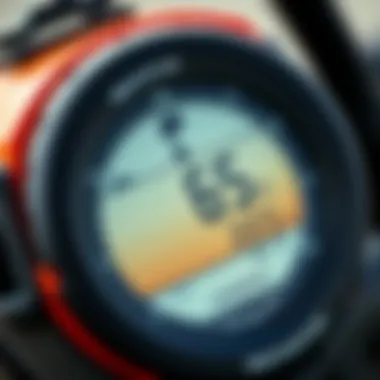
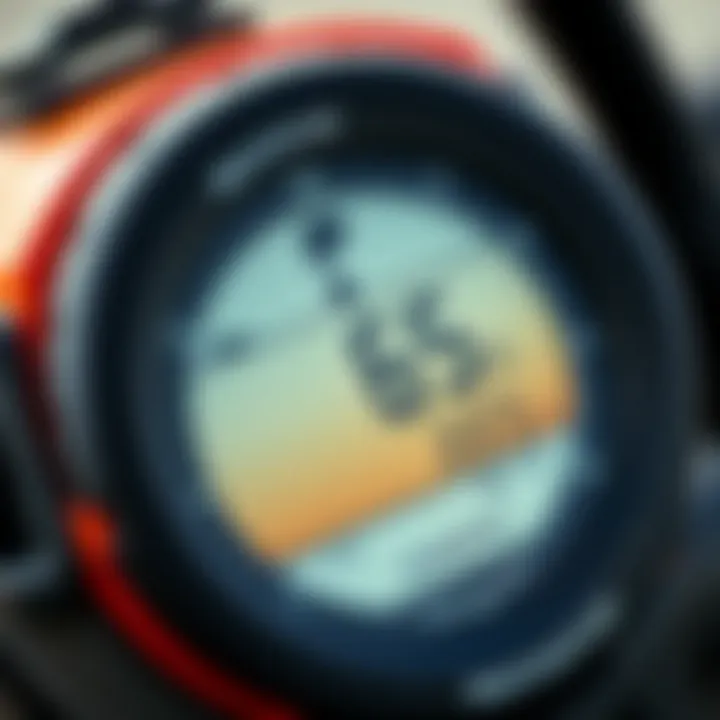
The Windmeter isn’t just about accurate data; it offers a user-friendly interface designed for simplicity. The app used to view wind data is straightforward, allowing you to comprehend complex data with ease. While you might be using high-tech equipment, you don’t have to master a complicated interface to grasp the information it provides.
- Data Visualization: The app features charts and graphs that clearly depict wind speed trends over time. Seeing how conditions have changed helps in future planning.
- User Customization: You can customize alerts based on wind conditions. Whether it's a gentle breeze or a full gale, being notified helps you stay ahead of the pack and make informed decisions.
"Inconsistent wind can lead to unpredictable riding conditions. The WeatherFlow Windmeter’s interface gives me confidence when I’m out on the water. I know exactly what to expect." - A seasoned kiteboarder.
In summary, the key features of the WeatherFlow Windmeter emphasize how technology can elevate the kiteboarding experience, ensuring not just performance but also safety. With highly accurate sensing technology, versatile data connectivity, and an easily navigable app, kiteboarders can feel empowered to make the most informed decisions on their adventure.
Setting Up Your WeatherFlow Windmeter
Setting up your WeatherFlow Windmeter is a cornerstone of ensuring you have the best experience while kiteboarding. A well-configured device leads to accurate readings, which are essential for gauging wind conditions before you hit the water. In the unpredictable world of kiteboarding, knowing exactly what the wind is doing can mean the difference between an exhilarating ride and a hazardous situation.
Unboxing and Components Overview
Unpacking your WeatherFlow Windmeter for the first time can be likened to unveiling a highly anticipated gift. As you pull back the lid, you will find:
- The WeatherFlow Windmeter unit.
- A USB charging cable.
- A quick-start guide to help get you rolling.
- A protective case for easy transport, because nothing should stand in the way of your kiteboarding adventures.
Each piece plays a role in ensuring your device functions optimally. The quick-start guide provides not just a glimpse into the device’s capabilities, but also critical safety information that every kiteboarder should consider.
Installation Process
The installation of your Windmeter is simpler than it sounds. Picture this: you’re on a beach, the sun is shining, and the wind is just right. You want your device swift and ready to go.
- Charge the Windmeter: Before attempting to set it up, connect it to a power source using the USB cable provided. A little juice goes a long way.
- Mounting: The WeatherFlow Windmeter can be placed either on a pole or on your existing kite, but here's a tip: make sure it's securely fastened to avoid losing it to a sudden gust.
- Connection: The device connects via Bluetooth to your smartphone, allowing you to access real-time data directly from the app. Make sure to enable Bluetooth on your mobile device as you go through the setup.
Just follow the easy steps from the app, and with a couple of taps, you'll have your Windmeter signaling that it’s ready for action.
Calibrating Your Device
Calibration is where things become a tad more technical, but don't worry, it's not rocket science. Think of calibration as fine-tuning your favorite instrument — ensuring everything is in perfect harmony. To ensure your readings are spot-on:
- Follow App Instructions: The app will guide you through a calibration process. This usually involves taking initial readings while in a calm setting.
- Wind Conditions: For best accuracy, perform this calibration in conditions similar to what you plan to encounter. If it's breezy, make sure to keep the device still.
Keeping your device calibrated not only boosts reading accuracy, but it can also help in gaining trust in the information it gives. Trust is the name of the game when you’re out on the water.
There’s a famous saying: "Measure twice, cut once." In the world of kiteboarding, it’s better to measure accurately once than to jump in with faulty data.
The setup process is designed to be user-friendly and intuitive. By taking the time to thoroughly set up and calibrate your device, you’re ensuring a safer, more enjoyable kiteboarding experience. After all, knowledge truly is power — especially when harnessed from mother nature herself.
Using the WeatherFlow Windmeter
When you're knee-deep in the exhilarating world of kiteboarding, understanding the intricacies of wind patterns is not just an advantage; it's a necessity. The WeatherFlow Windmeter stands as a pivotal tool in aiding kiteboarders to elevate their riding experience. So, let’s explore how this device can greatly enhance your time on the water, focusing on specific elements and benefits associated with it.
Understanding Wind Readings
Wind readings from the WeatherFlow Windmeter are vital for any kiteboarder. They provide real-time data regarding wind speed and direction. But what do those numbers really mean?
- Wind Speed: Measured in miles per hour (mph) or kilometers per hour (kph), knowing the wind speed helps you determine the right kite size. Too much wind and you might be overpowered; too little, and you won’t even lift off.
- Wind Direction: Often indicated in degrees, it informs you about where the wind is coming from. This information is crucial as it influences your approach to riding. For example, a cross-onshore wind might give you a safer ride compared to a strong offshore wind that could push you out to sea.
A deeper understanding of these readings can drastically shape your kiteboarding strategy. Rather than relying solely on guesswork, the WeatherFlow provides the necessary intelligence for decision-making.
Interpreting Wind Speed and Direction
Once you have the numbers in hand, the next step is interpretation. It’s like reading the tea leaves; knowing what the data means can mean the difference between a thrilling session and a day spent watching others ride.
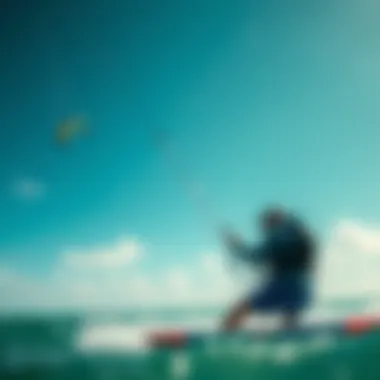
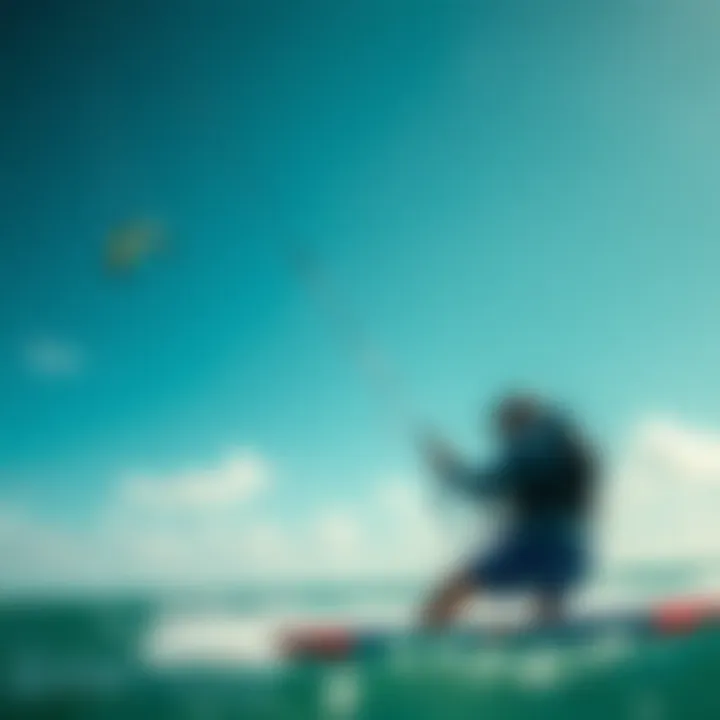
- Safe Wind Speeds for Beginners: Generally, wind speeds of 10-15 mph are considered suitable for newcomers. They offer a balance, giving enough push without overwhelming the rider.
- Directional Considerations: Understanding the wind’s direction can lead to deciding the best spot to launch your kite. Analyzing data helps identify kiteboarding hotspots, ensuring you’re not caught off guard.
Winds can change quickly, so it pays to keep an eye on the numbers, and the WeatherFlow Windmeter does this job exceptionally well.
Utilizing Data While Kiteboarding
Armed with your WeatherFlow Windmeter data, it’s time to hit the water. But how can you best utilize this information while kiteboarding? Here are a few strategies:
- Informed Kite Selection: Use precise wind readings to select the right kite. Wind conditions change rapidly, and having accurate measurements at your fingertips ensures you make timely adjustments—putting you ahead in the game.
- Adapt Your Riding Style: Depending on wind direction and speed, you might need to adjust your riding style. For instance, higher winds may require shorter lines or a different stance entirely.
- Plan Your Sessions: Knowing what the wind is doing allows you to create a game plan. Will you try new tricks in challenging conditions, or are you better off cruising on a calm day? Having reliable data can save you from frustrating sessions when conditions aren’t in your favor.
In summary, the WeatherFlow Windmeter isn’t just a tool; it’s a game-changer. It allows kiteboarders to navigate the whims of nature with confidence, ensuring that every ride is both safe and exhilarating. So whether you’re a novice or a seasoned pro, embracing this technology might just be the edge you need to master the winds.
The Benefits of Accurate Wind Measurement
Accurate wind measurement plays a fundamental role in the kiteboarding experience, where knowing the wind's behavior can mean the difference between a euphoric ride or a perilous situation. Let’s dive into the essential benefits that precise wind data offers kiteboarders, emphasizing safety, performance, and location selection.
Enhancing Safety in Kiteboarding
When it comes to kiteboarding, safety cannot be overstated. High winds or gusts can escalate quickly, leading to accidents or even severe injuries. With a device like the WeatherFlow Windmeter, kiteboarders can assess wind speed and conditions with precision. This real-time data allows for informed decisions about whether it's safe to hit the water.
For instance, if the Windmeter indicates wind speeds that significantly exceed a rider's skill level or equipment capability, it’s a clear signal to pause or reconsider.
Moreover, accurate measurements can prevent situations where a rider might be caught off guard by sudden changes in wind patterns. Knowing when to retreat or alter plans is crucial for maintaining safety.
Improving Performance on the Water
Accurate wind data directly impacts a kiteboarder's performance. Experienced riders often have a ‘feel’ for the wind, yet even the best can miss subtle changes. With a reliable wind measurement tool, kiteboarders can optimize their riding strategy.
If a kiteboarder knows that the wind speed is consistently ideal for their kite size, they can push their limits and explore advanced maneuvers with confidence. Conversely, if the Windmeter shows fluctuating winds, a rider can adjust their technique or select a different kite setup to maintain control.
- Consistent Performance: Relying on accurate readings, riders can achieve smoother transitions and enhanced control.
- Personal Growth: Gaining insight from wind data helps kiteboarders to improve their skills and develop new tricks seamlessly.
Choosing Optimal Locations for Riding
The right location can make or break a kiteboarding session, and understanding wind dynamics in various locales is key. With the WeatherFlow Windmeter, such decisions can be based on solid data rather than guesswork.
Kiteboarders can scout out spots and use historical data to determine which areas consistently provide optimal wind conditions. Furthermore, real-time readings can help riders avoid overcrowded spots or identify secluded beaches with ideal wind patterns.
Some effective strategies include:
- Using Wind Maps: Analyze historical wind data alongside current readings to visualize the best spots.
- Community Insights: Joining forums or local groups for anecdotal experiences about wind conditions at potential riding locations can complement your Windmeter's findings.
In a nutshell, accurate wind measurement is an invaluable asset for kiteboarders. From enhancing safety and performance to selecting the ideal riding locations, the WeatherFlow Windmeter emerges as a pivotal tool that every serious kiteboarder should consider.
"Data is not just numbers; it is the backbone of a safe and exhilarating kiteboarding experience."
As kiteboarders continue to embrace technological advancements, having precise information at your fingertips will enable every ride to be not just enjoyable, but also secure.
Comparing WeatherFlow Windmeter to Other Devices
When it comes to kiteboarding, knowing the ins and outs of wind conditions is vital. The WeatherFlow Windmeter isn’t just another device on the shelf; it’s a powerful tool that can be compared with various other wind measurement devices available. Understanding these comparisons doesn’t just help in recognizing where the WeatherFlow excels, but also highlights its potential shortcomings. This section aims to shed light on the distinct attributes that set the WeatherFlow apart, along with the aspects where it may not quite measure up.
Strengths of WeatherFlow
The appeal of the WeatherFlow Windmeter arises from several key strengths. First and foremost, its accuracy and precision are remarkable. The built-in sensors deliver wind speed and directional data that you can trust, which is pivotal when you’re planning your next ride. Here are a few strengths to consider:
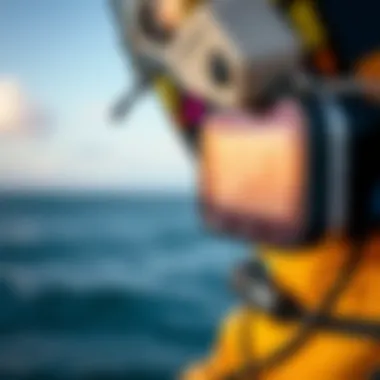
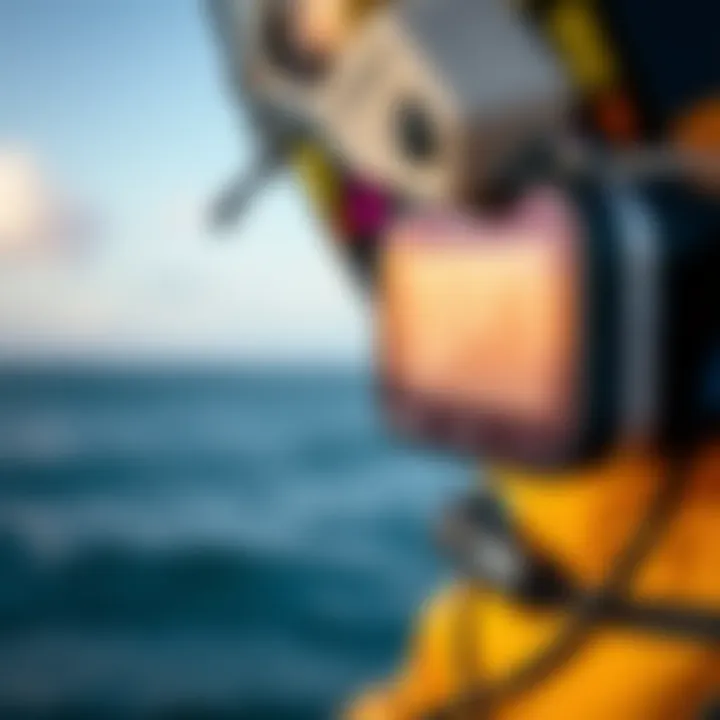
- Real-time Data: The device syncs with your smartphone to provide instant updates, making it easy to check conditions without any hassle.
- Portability: It’s lightweight and compact, allowing for easy transport to the beach or any kiteboarding location without feeling like you're lugging around a brick.
- Smart Technology Integration: The app goes beyond just presenting figures; it translates data into actionable insights, helping you read wind patterns more effectively.
- User-Friendly Design: With its simple interface, even those new to gadgets can easily see what they need at a glance.
"The WeatherFlow Windmeter has transformed how I check wind conditions. I've never felt more confident before hitting the water!"
Potential Limitations
Despite its strengths, it’s essential to consider some potential limitations of the WeatherFlow Windmeter that users might face. First off, while the data is generally reliable, variability can occur based on location and environmental factors. Here are a few things that one might find lacking:
- Battery Dependency: For continuous use, the device relies on batteries which need to be monitored and replaced periodically. If you're out for the day and the battery dies, you’re left guessing.
- Mobile App Connectivity Issues: Some users report occasional connectivity hiccups with the app, which can be frustrating when you're eager to get riding.
- Price Point: While many kiteboarders may find the WeatherFlow a worthy investment, it could be on the higher end for those just looking for basic weather data.
User Feedback and Reviews
Kiteboarding enthusiasts have shared their experiences, giving insights into the practical usage of the WeatherFlow Windmeter. What stands out in user feedback is a mix of admiration and criticism. Most riders praise the accuracy and ease of use:
- Positive Feedback: Many users commend the accuracy of wind readings, noting increased confidence in deciding to head out or stay put.
- Constructive Critiques: Others have mentioned that while wind readings are solid, the app could benefit from further enhancements in user experience.
- Community Reviews: A quick look through platforms such as Reddit reveals ongoing discussions where users compare it with alternatives like the Kestrel series or the SpeedTech. Some users have switched from these other brands, citing WeatherFlow’s unmatched data reliability.
Exploring both strengths and limitations gives kiteboarders a well-rounded view, helping them make informed decisions. Whether you’re looking for precision or simply the cost-effectiveness of devices, understanding where WeatherFlow fits into the broader landscape is crucial.
With such insights, riders can navigate their gear choices with greater awareness, ensuring each session is backed by reliable wind info.
Future Developments in Wind Measurement Technology
The landscape of wind measurement is ever-evolving, particularly in the context of kiteboarding where accurate data can mean the difference between a thrilling ride and a perilous experience. Future developments in this field promise a significant leap forward in how kiteboarders assess and interact with wind conditions. As those who ride the winds will know, staying abreast of improvements in technology isn't merely of academic interest — it directly impacts performance, safety, and overall enjoyment on the water.
Advancements in Sensing Technologies
Recent advancements in sensing technologies are paving the way for more precise and user-friendly wind monitoring devices. Features like miniaturized sensors and enhanced algorithms are now common. For instance, modern anemometers are being designed to provide real-time wind speeds with greater accuracy, catching even the slightest fluctuations. These improvements allow kiteboarders to make quicker, more informed decisions.
One exciting innovation involves the integration of laser sensing technology, which can measure wind speed and direction without the need for mechanical parts that can wear out or get damaged. This leap helps in keeping the instruments low-maintenance and more durable, especially in rugged outdoor conditions. Additionally, higher sensitivity levels in sensors will help distinguish between gusts that are relevant for kiteboarding and background noise caused by other environmental elements.
Furthermore, incorporating multi-directional sensors means that kiteboarders can receive comprehensive data about shifting wind patterns, crucial for anticipating changes while riding. In the palm of your hand, this data can translate into a significant edge while navigating challenging landscapes.
Integrating AI into Weather Systems
Artificial Intelligence (AI) is entering the sphere of weather measurement, offering kiteboarders a more tailored approach to understanding wind conditions. By harnessing machine learning algorithms, future wind meters will be able to analyze historical wind data patterns, predicting upcoming changes with remarkable precision.
Imagine this: a device that learns from your previous kiteboarding sessions, combining various data points, including local weather conditions and performance metrics, to offer personalized advice. Yes, it’s not just about displaying numbers anymore; it’s about interpreting them meaningfully. These systems could eventually send alerts when conditions are optimized for kiteboarding, which not only enhances safety but also maximizes the thrill of the sport.
The integration of AI is also projected to improve the usability of apps connected to these wind meters. Kiteboarders could receive push notifications about sudden wind shifts or optimal riding times straight to their smartphones, providing immediate access to critical data. This fusion of AI with mobile technology could create a more seamless experience for kiteboarders, allowing them to focus on the ride rather than worrying about the forecast.
"The future of wind measurement technology will not just keep kiteboarders informed; it will keep them ahead of the game."
Final Thoughts on the WeatherFlow Windmeter
In closing, the WeatherFlow Windmeter emerges as an invaluable ally for kiteboarders who seek to elevate their riding experience. With its advanced technology and user-friendly interface, this device offers precision and reliability that can make all the difference on the water. The way it adapts to kiteboarding needs is impressive; it’s akin to having a personal meteorologist by your side, ready to provide crucial data right when you need it.
Overall Assessment for Kiteboarders
When considering this tool, one must appreciate its multifaceted capabilities. The WeatherFlow Windmeter not only measures wind speed and direction but also translates this information into actionable insights. This means more time riding and less time guessing. Kiteboarders, both seasoned and novice, will find its real-time data particularly beneficial. Imagine arriving at your spot, checking the app, and knowing not just the wind conditions but also how they’ll affect your ride. It’s this level of preparedness that delineates an average day on the water from an extraordinary one.
Moreover, the sturdiness and portability of the Windmeter make it a perfect fit for outdoor enthusiasts who might venture into various environments. Whether you’re near the ocean’s edge or a scenic lake, this device stands ready to deliver consistent performance. Its seamless connectivity with smartphones means that you're not stuck looking at a screen while you should be soaking up the sun.
Making an Informed Purchase Decision
For those contemplating the purchase of a WeatherFlow Windmeter, it’s essential to weigh its benefits against your specific kiteboarding style. With prices that vary, one must consider how often they'll utilize the device and the types of conditions they will encounter. If you’re serious about kiteboarding, investing in this tool could very well be a game changer. Think of it as a safety net — giving you the confidence to hit the water knowing that you’ve got reliable data at your fingertips.
"Investing in the right gear can significantly enhance your kiteboarding experience and safety."
Before making a final decision, take a moment to read through third-party reviews and user experiences. Websites like Reddit and product review sites can provide additional insights that might help tip the scales. By arming yourself with knowledge and taking the time to understand your own needs, you can make a more informed choice that ensures every kiteboarding adventure is as thrilling and safe as possible.
In summary, the WeatherFlow Windmeter stands out as a smart investment for kiteboarders aiming to harness the power of wind data. With everything it offers, from safety enhancements to performance boosts, making this tool a part of your kit could very well be the next step in your kiteboarding journey.















